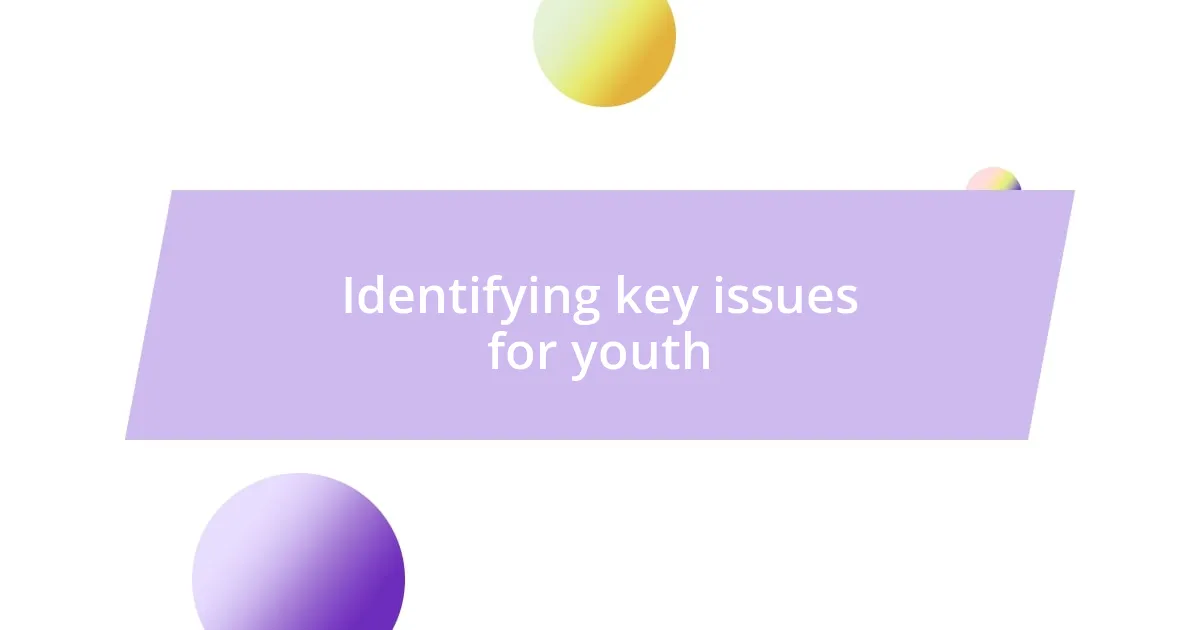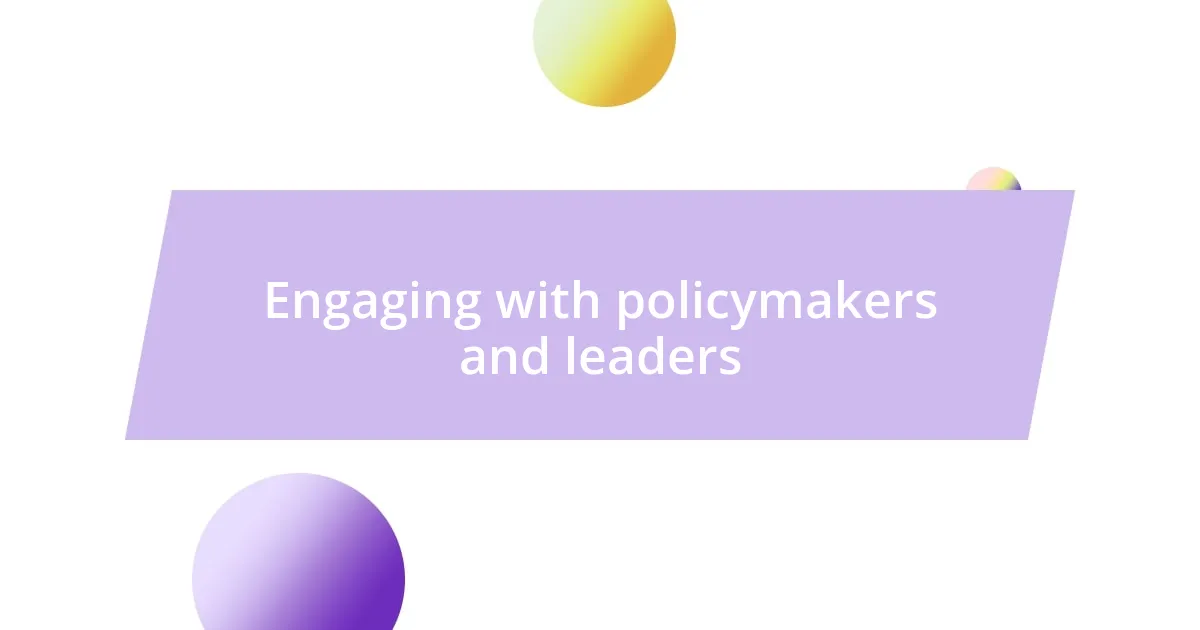Key takeaways:
- Youth advocacy empowers young voices, sparks innovative solutions, and fosters intergenerational dialogue, challenging the status quo.
- Engaging youth in discussions, especially at influential platforms like the Nobel discussions, amplifies their perspectives and experiences, instilling a sense of responsibility among mentors.
- Creating inclusive coalitions enhances the impact of youth advocacy, demonstrating the power of unity and collective action in addressing key issues.
- Measuring advocacy impact goes beyond attendance; it includes observing transformations in confidence and participation among youth, reflecting their growing role as change-makers.

Understanding youth advocacy importance
Understanding the importance of youth advocacy is a journey that has profoundly shaped my perspective. I remember attending a community meeting where a young advocate passionately presented their vision for environmental sustainability. Their clarity and commitment were electrifying, reminding me just how pivotal these voices are in shaping relevant discussions. When we listen to youth, we not only empower them but also gain fresh insights into the pressing issues that affect their futures.
Youth advocacy creates a bridge between generations, offering a platform for young people to express their ideas and concerns. Have you ever considered how young advocates challenge the status quo? I often reflect on how their unapologetic approach can inspire change in a way that seasoned voices might overlook. These advocates often bring innovative solutions to deeply rooted problems, challenging us to think critically about approaches that may no longer serve us well.
Moreover, the emotional weight behind youth advocacy cannot be understated. I recall a workshop where a teenager shared their story of feeling unheard yet determined to be a voice for their peers. The courage it takes to step into the spotlight, often in environments dominated by adults, demonstrates the tenacity and resolve of youth. Their passion fosters a sense of hope, pushing us to recognize the responsibility we have as mentors and allies in creating a more inclusive future.

My role in Nobel discussions
My role in Nobel discussions is multifaceted, and I often find myself in a position that feels both exhilarating and weighty. I remember sitting in a session where young voices were invited to express their ideas on global peace, and I was struck by their boldness. Their unfiltered thoughts challenged conventional notions and sparked meaningful debates among seasoned thinkers. In those moments, I realize that my role is not just to facilitate discussions but to amplify the voices of the youth. It’s a responsibility I take very seriously.
Being part of these discussions offers a unique chance to learn from young advocates. They bring a fresh perspective that reminds me to stay curious. I recall a specific instance when a young participant proposed a novel approach to collaborating on climate change initiatives. Their enthusiasm and innovative thinking left everyone in the room captivated. It made me reflect on how important it is to nurture such creativity, ensuring that it gets the attention it deserves in impactful dialogues like those at the Nobel discussions.
I find that advocating for youth in Nobel discussions also requires a deep sense of empathy. Connecting their lived experiences with broader global themes is crucial. One young advocate shared their journey of seeking educational opportunities despite various obstacles—listening to their story resonated with me on a personal level, reminding me of my own struggles and aspirations. This connection not only enriches the conversation but emphasizes the importance of fostering spaces where youth feel empowered to share their truth.
| Aspect | My Role |
|---|---|
| Voice Amplification | Facilitating youth engagement in discussions |
| Innovation Encouragement | Encouraging creative problem-solving from young advocates |
| Empathy Building | Connecting personal experiences to global issues |

Identifying key issues for youth
Identifying the key issues that resonate with youth today requires an attentive ear and an open heart. In my experience, I’ve often found that young people can articulate their concerns compellingly when provided with a safe space. Recently, during a brainstorming session, I noticed how passionately one youth spoke about the urgency of mental health support in schools. It struck me that many youth grapple with mental health challenges that sometimes go unnoticed, yet their bravery in sharing these experiences can pave the way for crucial conversations.
Key issues for youth often encompass various aspects of their lives, reflecting their realities and aspirations. Here are some of the most pressing concerns they face:
- Mental Health: Increasing anxiety and depression among youth demands more resources and dialogue.
- Education Accessibility: The disparity in access to quality education leaves many feeling marginalized.
- Climate Change: Young people are deeply concerned about environmental sustainability and their future on this planet.
- Social Justice: Issues surrounding equity and inclusion are at the forefront of many youth agendas.
- Digital Safety: The risks associated with social media and online interactions are significant, impacting their well-being.
By focusing on these areas, we can better understand the complex landscape that youth navigate daily. Sharing stories and fostering dialogues about these issues allows for informed advocacy that genuinely reflects their needs and aspirations.

Developing effective advocacy strategies
Developing effective advocacy strategies involves understanding the unique dynamics of youth perspectives. I often find that incorporating storytelling into my advocacy work resonates deeply with audiences. Recently, I shared a story of a young activist who rallied her peers around the importance of voting in local elections. Her determination and personal connection to the issue not only captured attention but also inspired action among other young people, highlighting the power of narrative in advocacy.
Moreover, creating collaborative platforms is essential for amplifying youth voices. In one initiative, I facilitated a workshop where young leaders brainstormed solutions to educational barriers they faced. The energy in the room was palpable as ideas flowed freely. It made me realize how much more effective our strategies could be if we prioritized peer-to-peer initiatives that foster skill-sharing and empower youth to take ownership of the conversations affecting their lives.
Effective advocacy also hinges on establishing trust and open lines of communication. There was a moment during a roundtable discussion when a young participant hesitated to share his thoughts. I asked him what would make him feel more comfortable. His response was simple yet profound: “Just listen to me.” This highlighted how crucial it is to create spaces where young people feel valued and respected. When they sense that their voices matter, their contributions can spark transformative changes in discussions, bringing fresh solutions to longstanding issues.

Building coalitions for youth voices
Building coalitions for youth voices is not just about gathering people; it’s about creating a genuine community rooted in shared experiences and goals. I recall a time when I partnered with a group of local youth organizations for an event focused on environmental advocacy. The excitement was evident as various young advocates shared their stories and strategies. It struck me how these diverse voices, when united, created a much stronger impact than if we had each acted alone. Why does unity matter? Because young people want to feel like they are part of something greater, something that can truly make a difference.
To effectively amplify youth voices, I believe in fostering inclusive environments where everyone’s perspective is honored. In one coalition meeting, I noticed a shy participant whose ideas were invaluable but remained unheard. I encouraged her to share, and immediately, the conversation shifted—the entire group responded with enthusiasm. It reminded me that everyone has something important to contribute, and when we listen actively, we enable the full spectrum of youth potential to shine through.
Creating these coalitions is not without its challenges. I remember facing pushback from some adult stakeholders who underestimated the power of youth involvement. Rather than being deterred, we organized a youth-led presentation showcasing our findings and recommendations. That experience taught me a vital lesson: by standing together and presenting our shared vision confidently, we can challenge misconceptions. This coalition not only validated our voices but also shifted the narrative around youth agency in our community discussions. Isn’t it empowering to realize that when we unite, we can influence the future?

Engaging with policymakers and leaders
Engaging with policymakers and leaders is a pivotal part of advocating for youth. I vividly remember my first encounter with a local policymaker. I was nervous but excited, armed with data and stories from my peers. I decided to share a gripping narrative about a friend’s struggle to access mental health resources. The policymaker leaned in, captivated by the story. It drove home the point that personal stories, paired with facts, can open up the hearts of those in power.
One strategy I’ve found effective is setting up informal meetings where youth can speak freely. During one gathering, a young person shared her frustration about barriers to education. I watched as her raw honesty shifted the atmosphere—suddenly, policymakers were not just leaders, but active listeners, eager to understand. This blend of openness and sincerity fosters a genuine relationship, making it easier for youth to voice their concerns and feel validated.
Sometimes, the biggest hurdle is breaking down the barriers between youth and leaders. I remember feeling a sense of urgency when I learned that a critical policy meeting was happening without any youth representatives. So, I organized a pre-meeting session, gathering young voices to discuss our priorities. Being proactive turned into a vibrant dialogue, and by the time we met with the leaders, they were already aware of our key concerns. Isn’t it remarkable how taking the initiative not only amplifies youth voices but also makes policymakers reconsider their approach?

Measuring impact of advocacy efforts
Measuring the impact of advocacy efforts involves more than just tracking attendance or social media likes; it’s about recognizing the shift in attitudes and behaviors that arise from genuine engagement. I remember standing in front of a group after an advocacy workshop and witnessing a spark of inspiration in their eyes. When young people start to articulate their ideas confidently and take initiative in discussions, it’s a clear sign that our efforts are resonating. This transformation is what I cherish most; it’s where true change begins.
One effective method I’ve employed is using feedback surveys after events to gauge the sentiments of participants. I was pleasantly surprised when one young advocate shared that the workshop had empowered her to voice her opinions in school debates for the first time. Hearing that made me realize how vital our initiatives were in shaping the confidence and capabilities of youth. Have you ever felt the joy of knowing your work made a difference, even in ways you didn’t anticipate? It’s rewarding to see advocacy manifest in individuals’ journeys, driving home that our collective efforts lead to meaningful impact.
Additionally, tracking the presence of youth in decision-making spaces gives insight into our advocacy’s success. I once tracked a substantial increase in youth representation at local council meetings, which directly correlated with our outreach campaigns. Knowing that our advocacy contributed to this change was exhilarating. Each young person present added unique perspectives. It underscored that measuring impact is both quantifiable and qualitative, as these moments reflect growth in the youth’s role as change-makers within their communities. Isn’t it exciting to think about how every voice contributes to a larger narrative?














